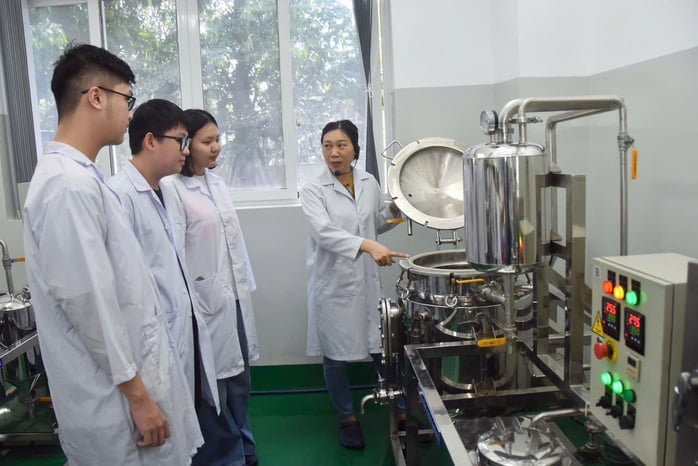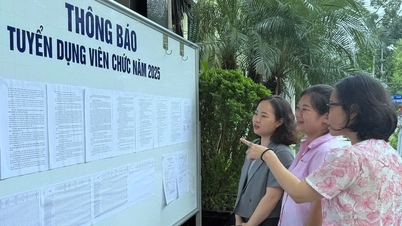The Ministry of Education and Training (MOET) has assessed that the current university education system is developing unevenly. Many universities are small in scale, have narrow training fields, and operate ineffectively.
There are many schools but not many students!
Currently, the country has more than 300 higher education institutions, including 11 universities (2 national universities, 3 regional universities, 6 universities) upgraded from universities according to the Law on Higher Education 2018; 173 public universities and academies (not including member schools of national universities and regional universities); 62 private universities and 5 foreign universities; 8 training schools with university education activities; 31 schools in the defense and security sector; 40 research institutes training at doctoral level; 5 other facilities training masters and doctors.
In addition, the country also has 26 higher education institutions under the People's Committees of provinces and centrally run cities (collectively called local universities). Most of these schools are small in scale, contributing only 6.3% of the total training scale of university level, 3.5% of masters and 1% of doctorates of the whole system; only 3 schools have a scale of more than 10,000 students, while there are 8 schools with a scale of less than 2,000 students.
Nam Dinh University of Technical Education has 16 majors, the total enrollment target of the school in 2024 is 800, the number of candidates confirmed to enroll is 331. In previous years, the school also fell into a difficult enrollment situation.
Ha Tinh University is also in a similar situation when in 2023 and 2024, only Primary Education has enough enrollment quota, while the remaining 11 majors are having great difficulty enrolling students.

Students of Ho Chi Minh City University of Industry and Trade during a practice session. (Photo for illustration purposes only). Photo: TAN THANH
Phu Yen University has a target enrollment of 590 students in 2025, of which 6 majors in education account for nearly 50% of the enrollment target. The university's education majors have met their enrollment targets, but other majors have difficulty enrolling. This is also the common situation of many other local universities, and without education, these schools will have difficulty developing.
Similarly, many universities under ministries and sectors are also in a difficult situation. Quang Ninh University of Industry - under the Ministry of Industry and Trade - in 2024 recruited more than 770 students but only 222 students were admitted and many majors could not recruit students.
According to the Ministry of Education and Training, the university education "market" has not been regulated at the macro level, most universities have not clearly defined their development strategies; the system has not been clearly classified; the leading role of national universities and regional universities is not clear. Meanwhile, the management model of state agencies is inconsistent and fragmented (under the direct control of many ministries, branches and localities).
To make the system strong, it must be rearranged.
The Ministry of Education and Training believes that the main cause of the current weaknesses of the university education network is the "fragmentation" in state management. In addition, there are inequalities and lack of transparency in mechanisms, policies, and allocation of state resources; low efficiency of investment in university education; and no or weak competitive motivation in the system.
Resolution 71-NQ/TW of the Politburo dated August 22, 2025 on breakthroughs in education and training development clearly pointed out that the university and vocational education systems are fragmented and outdated, failing to meet the requirements of training high-quality human resources and scientific research, especially in a number of key sectors and fields.
The Politburo requested to reorganize and restructure higher education institutions; merge and dissolve lower-standard higher education institutions; study the merger of research institutes with higher education institutions; and study the transfer of some universities to local management to improve management efficiency and better meet local human resource training requirements.
Thus, the arrangement and reorganization of Vietnam's university education system is becoming an inevitable trend. Many experts believe that the policy of merging, consolidating or dissolving weak training institutions is no longer an "if" but a "when" to have a strong university education system.
Dr. Nguyen Duc Nghia, former Vice President of Ho Chi Minh City National University, said that the period of the strongest increase in the number of schools took place in 5 years (2005 - 2010) - an increase of 76 colleges and 48 universities. Many new schools established in this period were "upgraded" from colleges.
In the period 2005 - 2010 alone, the number of schools increased by an average of 8.3% per year; the number of students increased by 9.7% and the number of lecturers increased by 10%. Overall, within 20 years (2005 - 2025), the number of universities has nearly doubled - from 137 universities (public and non-public) to 264.
This "massification" process, although successful in expanding access to higher education for millions of young people, has taken place relatively spontaneously and without a coherent overall plan. Therefore, the policy of merging and restructuring the higher education system is an urgent requirement, stemming from objective demands for domestic and international socio-economic development. "Optimizing national resources, improving quality and international competitiveness is a command of the integration era, meeting the requirements of the labor market in the digital age" - Dr. Nguyen Duc Nghia emphasized.
Associate Professor Dr. Ho Thanh Phong, former Principal of the International University - VNU-HCM, said that the Vietnamese university education system is developing unevenly, many universities cannot meet the demand for training high-quality human resources, including public universities. Therefore, the university education system should be reorganized and merged to make the system stronger. "Even cars have to be "tuned" to be able to race" - Associate Professor Phong said.
Designation of merger facilities
At the 2025 University Education Conference, Minister of Education and Training Nguyen Kim Son said that in the near future, university education will enter a period of arrangement, merger, and streamlining.
Accordingly, the facilities may be designated for merger, not selected by the units. For non-public schools, they will be resolved by themselves; educational facilities of the police and military sectors will follow the vertical management of their ministries and branches.
After subtracting the above number, there are currently about 140 public universities. In particular, schools that are close to each other in terms of fields will merge to overcome the fragmented, small and undeveloped situation.
Lessons learned from the 30-year-old arrangement
Associate Professor, Dr. Thai Ba Can, Principal of Gia Dinh University (HCMC), said that more than 30 years ago, Vietnam also had a period of university reorganization to create 2 national universities and then regional universities with member universities. However, that reorganization process was not as expected, the model was not determined because even the name was still uncertain. Learning from the reorganization 30 years ago, if this merger and reorganization is implemented, the goal must first be determined, such as building a strong university education system, including a number of elite educational institutions... and should not simply be to streamline the apparatus and reduce the number of units.
According to Associate Professor, Dr. Thai Ba Can, to build a strong university education system, it is necessary to gather resources, including lecturers and facilities. However, when arranging, it is necessary to determine the model, not to arrange mechanically. When there is a model and criteria, the arrangement will be more favorable.
Next: What will the "grand reorganization" of universities be like?
Source: https://nld.com.vn/sap-xep-lai-he-thong-dai-hoc-la-tat-yeu-196250930220732491.htm



![[Photo] Binh Trieu 1 Bridge has been completed, raised by 1.1m, and will open to traffic at the end of November.](https://vphoto.vietnam.vn/thumb/1200x675/vietnam/resource/IMAGE/2025/10/2/a6549e2a3b5848a1ba76a1ded6141fae)




























































































Comment (0)